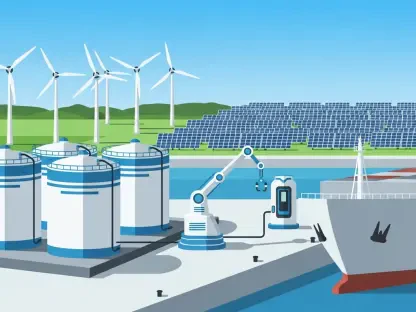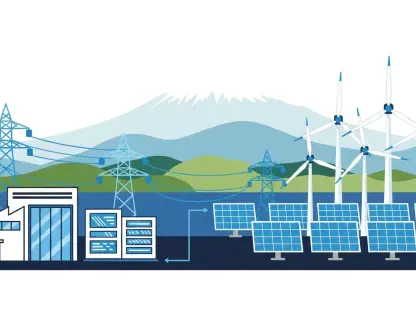Imagine a world where the aviation industry, a cornerstone of global connectivity, slashes its carbon footprint without compromising efficiency, transforming the way we travel and transport goods. With air travel and cargo transport contributing significantly to greenhouse gas emissions, the urgent need for sustainable solutions has never been clearer. Sustainable Aviation Fuel (SAF) emerges as a game-changer, promising to transform an industry historically tethered to fossil fuels. This review delves into the intricacies of SAF, exploring its technical prowess, real-world impact, and the collaborative efforts driving its adoption, spotlighting a pivotal partnership between Finnair and CN Logistics.
Core Technology and Performance Metrics
Feedstock Diversity and Production Innovation
At the heart of SAF lies a diverse array of feedstocks, ranging from waste oils and agricultural residues to cutting-edge synthetic fuels. These materials undergo sophisticated conversion processes, such as hydroprocessing and Fischer-Tropsch synthesis, to produce a fuel that mirrors the performance of traditional jet fuel. The significance of this versatility cannot be overstated, as it allows production to adapt to regional resource availability, reducing dependency on finite fossil resources.
Equally critical is SAF’s compatibility with existing aircraft engines, a feature that eliminates the need for costly infrastructure overhauls. Energy density, a key performance metric, remains comparable to conventional fuels, ensuring that flight ranges and payload capacities are unaffected. This seamless integration into current systems positions SAF as a practical solution for airlines aiming to transition toward sustainability without sacrificing operational reliability.
Emissions Reduction and Environmental Impact
One of SAF’s most compelling attributes is its capacity to curb greenhouse gas emissions, often achieving reductions of up to 80% over the fuel’s lifecycle compared to traditional kerosene, depending on feedstock and production methods. Lifecycle assessments reveal that by utilizing waste materials, SAF minimizes the carbon intensity associated with raw material extraction and processing. This stark contrast to fossil fuels underscores its environmental value.
Real-world data from commercial flights and cargo operations further validates these claims. Airlines incorporating SAF report measurable decreases in their carbon output, contributing to broader climate goals. Such performance characteristics highlight SAF as not just an alternative, but a cornerstone for achieving net-zero ambitions in aviation, with tangible benefits already evident in day-to-day operations.
Recent Advancements and Industry Adoption
The past few years have witnessed remarkable strides in SAF technology, particularly in scaling production to meet growing demand. Innovations in refining techniques have lowered production costs, making SAF a more viable option for widespread use. Regulatory frameworks, including incentives and mandates, are also evolving to support adoption, with governments and industry bodies aligning on sustainability targets.
Partnerships across the aviation and logistics sectors are accelerating this momentum. Collaborative efforts focus on shared investments in SAF supplies, ensuring a steady pipeline for integration into regular operations. These alliances reflect a collective recognition that sustainability is not a solo endeavor but a shared responsibility, with emerging trends pointing toward deeper integration of green practices in global supply chains.
A notable shift is the commitment to long-term goals, such as reducing emissions per ton of cargo by significant margins over the coming decade. From 2025 to 2033, targets validated by initiatives like the Science Based Targets are pushing companies to adopt SAF alongside other efficiency measures. This forward momentum signals a maturing market ready to embrace cleaner fuel alternatives.
Real-World Impact and Notable Case Studies
The practical deployment of SAF is gaining traction, with airlines and logistics firms integrating it into both passenger and cargo operations. A standout example is the collaboration between Finnair and CN Logistics International Holdings, a Hong Kong-based firm under DP World. By funding SAF supplies, CN Logistics enables Finnair to lower emissions tied to its cargo shipments, blending environmental stewardship with operational efficiency.
Finnair’s efforts extend beyond fuel, as seen in facilities like the COOL Nordic Cargo Hub at Helsinki Airport. This state-of-the-art cargo center leverages energy-saving technologies, including solar panels that supply a substantial portion of its power needs. Combined with automated systems and waste management innovations, it exemplifies how SAF adoption pairs with infrastructure upgrades to amplify sustainability.
This partnership serves as a blueprint for the industry, demonstrating that targeted collaborations can yield measurable environmental benefits. CN Logistics’ “CNL Green Solution” program aligns seamlessly with Finnair’s vision, showcasing how diverse stakeholders can unite under a common goal. Such case studies illuminate SAF’s role as a catalyst for systemic change in air freight and beyond.
Challenges Hindering Broader Adoption
Despite its promise, SAF faces significant hurdles in achieving widespread use. Production costs remain high compared to conventional jet fuel, creating a financial barrier for many airlines and logistics providers. Scaling up manufacturing to meet global demand also poses technical challenges, as current facilities are limited in capacity and geographic reach.
Regulatory and market barriers further complicate the landscape. Inconsistent policies across regions create uncertainty for investors and adopters, while the lack of standardized certification for some SAF types can slow integration. These obstacles highlight the need for harmonized global standards and greater policy support to level the playing field.
Efforts to address these limitations are underway, with industry stakeholders advocating for innovation and collaboration. Joint initiatives between airlines, fuel producers, and governments aim to drive down costs through technological advancements and economies of scale. Overcoming these challenges remains a critical step toward making SAF the norm rather than the exception in aviation.
Future Trajectory and Potential Breakthroughs
Looking ahead, the trajectory of SAF appears promising, with potential breakthroughs in production technology poised to enhance cost-effectiveness. Research into novel feedstocks and more efficient conversion methods could further reduce environmental impacts while boosting output. These advancements are expected to play a pivotal role in meeting the aviation sector’s ambitious net-zero targets.
Broader industry adoption is also on the horizon, as more companies commit to sustainability goals over the next decade. From 2025 to 2035, the focus will likely shift toward integrating SAF into standard fuel blends, supported by expanding infrastructure for distribution. This gradual mainstreaming could redefine global trade and travel, aligning aviation with climate mitigation efforts.
The long-term impact of SAF extends beyond emissions reduction, potentially reshaping supply chains and international logistics. As adoption grows, the technology could foster a more resilient and environmentally conscious industry, setting a precedent for other sectors. The coming years will be crucial in determining how swiftly these possibilities become reality.
Final Thoughts and Next Steps
Reflecting on the journey of Sustainable Aviation Fuel, it becomes evident that this technology marks a turning point for aviation and logistics. Its ability to cut emissions while maintaining compatibility with existing systems stands out as a testament to innovation meeting practicality. The partnership between Finnair and CN Logistics proves that collaborative efforts can drive meaningful progress in reducing the carbon footprint of air cargo.
Moving forward, the industry must prioritize investment in research to further lower SAF production costs and enhance scalability. Governments and regulatory bodies should work toward unified policies that incentivize adoption and standardize certification processes. These actionable steps can bridge current gaps and accelerate the transition to sustainable aviation.
Beyond immediate actions, fostering a culture of shared responsibility among stakeholders remains essential. Encouraging more airlines and logistics firms to emulate successful models of collaboration can amplify impact. By building on these foundations, the aviation sector can solidify SAF’s role as a cornerstone of a greener, more sustainable future.









